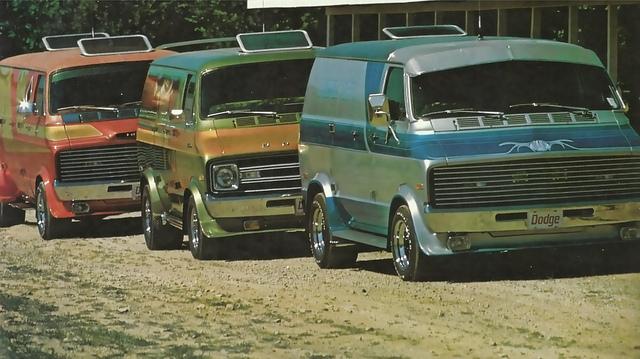The Dealer Who Swindled $6 Billion From General Motors

In the opening moments of the above scene from the flick “Fargo,” Oldsmobile dealership sales manager Jerry Lundegaard is working up some bogus paperwork to cover his tracks with General Motors Acceptance Corporation (GMAC). We can infer that he sold some floor-planned cars and did not pay back GMAC, which was the impetus for the movie’s storyline of his bumbling attempt to extort money from his father-in-law.
Jerry’s store may have been “out of trust” with GMAC on a few dozen 1987 Cutlasses, but that pales in comparison to the scheme concocted by New York car dealer John McNamara.
Between 1980 and 1991, McNamara convinced GMAC to advance him $6.2 billion to pay for 248,000 conversion vans that did not exist. It was one of the largest Ponzi schemes in history and ended up costing GMAC $436 million, equal to $725 million in today’s dollars.
We would like to show you a photo of McNamara but none are to be found. That may be because it is believed he went into the Witness Protection Program a few years after his conviction for fraud in 1992. Just picture Lundegaard with a really big brain.
McNamara’s brilliant swindle was deliciously simple. It was based on one undeniable truth he learned from his years of owning a Buick-Pontiac-GMC dealership on Long Island: General Motors and GMAC were too incompetent and too bureaucratic to figure out that they were being scammed.
Born in 1940, John McNamara took over his father’s Port Jefferson, NY Buick dealership in 1978 (car company employees reading this are all now thinking, “Ah, he was a dealer’s son, that explains it all!”) In 1990, he approached GMAC with a request for them to floorplan conversion vans that he was going to have built and then exported. He informed GMAC that his store was going to buy the vans from an Indianapolis conversion company called Kay Industries. McNamara told GMAC he had a buyer for the all the units in Cyprus and they would distribute them throughout Southeast Asia.
Kay Industries was not a recreational vehicle factory but rather an empty office that McNamara had set up, furnished only with a phone that forwarded calls to his operations in Long Island.
There were probably around 30 or so van conversion outfits in the U.S. at the time, the majority of them being located 150 miles north of Indianapolis in Elkhart, Indiana, the center of the domestic RV industry. Using an Indiana address gave McNamara’s fake company credibility, but using an Elkhart address would have been too risky as there would have been too many General Motors reps sniffing around.
McNamara’s Buick store would “buy” the vans from Kay Industries and proceeded to produce MSOs with fake VINs which they forwarded to GMAC to obtain the financing. (It is not clear but we assume the vans were all Fords and Dodges because even the bold McNamara would not risk using Chevrolet and GMC vans so as not to risk GMAC from cross-checking VINs with General Motors.) The vans were then “sold” to another sham McNamara company, an auto export firm called Harbor East Equities, which in turn “sold” them to the bogus Cyprus firm Cydonia Trading Ltd.
So Kay Industries started cranking out thousand of vans per month, instantly becoming one of the highest volume converters in America and GMAC dutifully handed over an estimated $25,000 per phantom unit to McNamara, all based on bogus paperwork.
A real van conversion factory; McNamara’s facility was an empty office in Indianapolis.
GMAC was oblivious to the implications of a previously unknown company building a high volume of units, despite them working with other van conversion firms. No GMAC official ever drove the 240 miles from their Detroit headquarters to visit Kay Industries. No calls from GM Detroit headquarters to the General Motors Indianapolis zone office were ever placed (“My God, Bob, GMAC is flooring a zillion Ford and Dodge conversion vans out of a factory in your backyard. Go visit them and get them to switch to Chevy and GMC chassis!”)
Instead, GMAC modified its computer systems to accommodate the added volume. They would occasionally shut down their Long Island zone office so employees could concentrate on processing McNamara’s paperwork. Those sessions were nicknamed by employees as, “Mac Attacks,” or “Give McNamara Another Car (GMAC)” days. They gave him 60 days to pay, twice their norm. The bank probably profited $50 million on floorplan interest over the years from McNamara, so they were intent on giving their important client the best service possible.
Meanwhile, McNamara was spending the money like a drunken, well, car dealer. He purchased a golf course in Florida, a private jet, over 100 properties and a Nevada gold mine. In a delicious irony, he bought an auto finance company, one of over 70 firms he owned or in which held a partnership. His net worth soared to over $300 million.
For ten years McNamara paid GMAC back the floorplan loans with interest like clockwork using proceeds from GMAC’s newer loans, but naturally had to increase his volume to maintain his lifestyle. He became a mini-Bernie Madoff, always betting that the stream of cash would never end.
By 1991, Kay was “producing” an astounding 53 percent of all conversion vans built in America. In December of 1991, Kay actually out produced all other U.S. van customizers combined by building 17,000 units on paper. John McNamara’s greed was out of control.
That milestone month triggered the beginning of the end for McNamara. A GMAC bean counter raised a red flag over Kay’s $425 million month and the company soon noticed that the VINs in question never turned up in registration reports. They asked McNamara where the 17,000 vans were located and he said 11,000 were still at the plant being converted and 6,000 were already shipped overseas.
We can only imagine the look on the face of the GMAC official who went to check out Kay Industries and discovered the empty office and realized his company had been snookered. The company notified the Department of Justice.
McNamara was arrested in April 1992 and charged with mail fraud, wire fraud and money laundering. His assets were seized but he did make his $300 million dollar bail, presumably money he somehow made outside the scam.
McNamara later testified that it was “easy” to fool General Motors. When GMAC would conduct surprise floorplan checks at his store, he claimed to always be tipped off as to when they would be coming and would manage to convince them that the vans existed.
This testimony from a later case involving McNamara from an article in the The New York Times may explain why the scam went undetected for so long:
Once, Mr. McNamara said, he received a call from a financing agency official in Detroit, who told him that the company’s computers would not accept the serial numbers the dealer was supplying. “The computer was spitting out the serial numbers,” Mr. McNamara said, adding that the G.M.A.C. employee asked him what he wanted to do about it.
“I asked, what’s easiest for him?” Mr. McNamara recalled. “He said, ‘To override the computer and accept the serial numbers.'” Mr. McNamara said he told the worker it seemed a fine idea to him, and it was done.
He also stated that he gave free service and deep discounts on vehicles to local GMAC officials, a charge GMAC denied.
He would plead guilty in September 1992 and faced 20 years in jail and an $800 million fine.
This is where the story gets blurry. McNamara mysteriously was allowed to remain free and got to keep around $2 million in assets. Lead prosecutor assistant U. S. Attorney Loretta Lynch, now U. S. Attorney General, admitted that McNamara was leading a personal life similar to pre-conviction. He opened an auto parts supply company and continued to live in his Long Island mansion. McNamara transferred all of his homes to his then-girlfriend Diane Dangerfield. (Based on her great name alone, Hollywood should have made a movie about this story.)
It turns out the Feds wanted him to finger some local politicians he admitting to have paid off for favors on his building projects in exchange for a reduced sentence of 5 years and a chance to enter the federal Witness Protection Program. Three of those officials were later acquitted of bribery in 1995.
After that, the news stories stopped. Where is the now 75-year-old John McNamara?
When GMAC pulled McNamara’s line of credit, they would not get reimbursed for $436 million dollars worth of vans. Their reaction to this embarrassing loss was to force the retirement of, or reassign and discipline, a handful of managers. In what must be the greatest corporate spin of all time, GMAC said their internal investigation of the McNamara case “did not reveal systemic problems with GMAC’s operating and control procedures in its core business functions.”
One final note: when John McNamara was first confronted by federal officials he reportedly said, “What took you so long to catch me?” Or as Jerry Lundegaard said above, “I’m cooperating here!”

More by Steve Lynch
Latest Car Reviews
Read moreLatest Product Reviews
Read moreRecent Comments
- AZFelix With both fuel lines and battery packs, Lamborghini owners can soon wager on which part of the engine will instigate the self immolation of their super cars.
- Namesakeone The realities of the market have spoken: with a little help of a lingering recession (in that most families need a car for every purpose, rather than affording multiple cars as once was true), and with a little advertising-prodding from the manufacturers, the SUV and crossover have, in turn, replaced the station wagon, the minivan, and now the sedan. (Or maybe the minivan replaced the station wagon. Whatever.) I still like cars, but the only votes are the ones that a.) come to new-car dealerships, and b.) come with money attached. Period.
- MaintenanceCosts "But your author does wonder what the maintenance routine is going to be like on an Italian-German supercar that plays host to a high-revving engine, battery pack, and several electric motors."Probably not much different from the maintenance routine of any other Italian-German supercar with a high-revving engine.
- 28-Cars-Later "The unions" need to not be the UAW and maybe there's a shot. Maybe.
- 2manyvettes I had a Cougar of similar vintage that I bought from my late mother in law. It did not suffer the issues mentioned in this article, but being a Minnesota car it did have some weird issues, like a rusted brake line.(!) I do not remember the mileage of the vehicle, but it left my driveway when the transmission started making unwelcome noises. I traded it for a much newer Ford Fusion that served my daughter well until she finished college.



































Comments
Join the conversation
My dad was a salesman at McNamara in the 80s. I almost bought a Grand National from him he kept pushing that damn true coat on me. But seriously, I bought a Mustang GT instead. That’s one of my regrets, never buying a car from my dad. Speaking of true coat, back in the 70s he sold an undercoating job on a new car. I don’t know why it didn’t get done before delivery (I was just a kid) but he bought a couple cans of undercoating spray from the local auto parts store and applied it himself while lying on the ground. His arms were black up to his elbows when he came home that night. I miss my dad.
I actually used to work for this guy